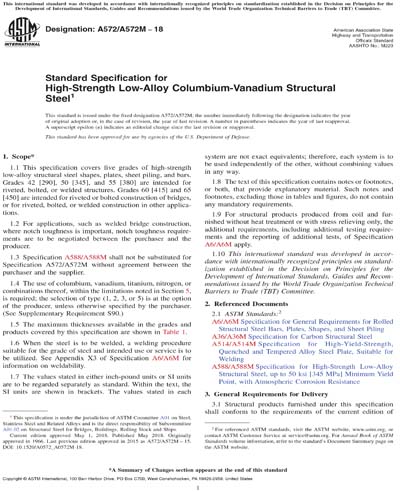Historical
ASTM A572/A572M-18
Standard Specification for High-Strength Low-Alloy Columbium-Vanadium Structural Steel
1.1 This specification covers five grades of high-strength low-alloy structural steel shapes, plates, sheet piling, and bars. Grades 42 [290], 50 [345], and 55 [380] are intended for riveted, bolted, or welded structures. Grades 60 [415] and 65 [450] are intended for riveted or bolted construction of bridges, or for riveted, bolted, or welded construction in other applications.
1.2 For applications, such as welded bridge construction, where notch toughness is important, notch toughness requirements are to be negotiated between the purchaser and the producer.
1.3 Specification A588/A588M shall not be substituted for Specification A572/A572M without agreement between the purchaser and the supplier.
1.4 The use of columbium, vanadium, titanium, nitrogen, or combinations thereof, within the limitations noted in Section 5, is required; the selection of type (1, 2, 3, or 5) is at the option of the producer, unless otherwise specified by the purchaser. (See Supplementary Requirement S90.)
1.5 The maximum thicknesses available in the grades and products covered by this specification are shown in Table 1.
1.6 When the steel is to be welded, a welding procedure suitable for the grade of steel and intended use or service is to be utilized. See Appendix X3 of Specification A6/A6M for information on weldability.
· Structural shapes
· Sheet piling
· Bars
· Plates with widths up to and including 15 in. [380 mm]
1.7 The values stated in either inch-pound units or SI units are to be regarded separately as standard. Within the text, the SI units are shown in brackets. The values stated in each system are not exact equivalents; therefore, each system is to be used independently of the other, without combining values in any way.
1.8 The text of this specification contains notes or footnotes, or both, that provide explanatory material. Such notes and footnotes, excluding those in tables and figures, do not contain any mandatory requirements.
1.9 For structural products produced from coil and furnished without heat treatment or with stress relieving only, the additional requirements, including additional testing requirements and the reporting of additional tests, of Specification A6/A6M apply.
1.10 This international standard was developed in accordance with internationally recognized principles on standardization established in the Decision on Principles for the Development of International Standards, Guides and Recommendations issued by the World Trade Organization Technical Barriers to Trade (TBT) Committee.
Content Provider
ASTM International [astm]






